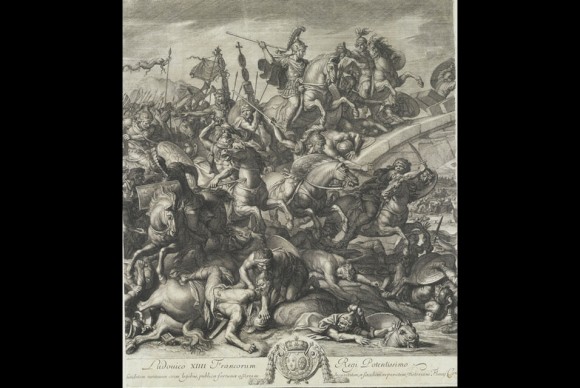Getty Explores the Works of Late 17th-Century Celebrated French Printmakers
LOS ANGELES, CA.- Printing the Grand Manner: Charles Le Brun and Monumental Prints in the Age of Louis XIV on view at the Getty Research Institute from May 18 through October 17, 2010, explores a little-known facet of late 17th-century reproductive engravings. The exhibition examines the prints’ rich vocabulary and illuminates the context in which they were made between the mid-1660s and the mid-1680s. While it focuses on the relationship between Charles Le Brun (French, 1619–90) and the printmakers who reproduced his compositions, the exhibition also interprets the prints and their inscriptions in light of Le Brun’s ambitions and struggles as a court painter, designer, and print publisher in the highly competitive atmosphere surrounding Louis XIV.
The works in this exhibition and related catalog reproduce Le Brun’s narrative compositions in the Grand Manner, the genre in which a heroic protagonist engages in a morally significant action—a battle to be won, a victory to be celebrated, or a vice to be avoided. By disseminating these subjects in printed form, Le Brun presented to both collectors and artists his mastery of the most complex type of art. In turn, the quality and size of these prints allowed him to demonstrate the unprecedented authority over the fine arts in France.

Audran, Gerard (1640-1703) and after Le Brun, Charles (1619-1690), Battle at the Milvian Bridge : detail center, 1666. Etching and engraving, center sheet: 74.2 x 102.2 cm (29 3/16 x 40 1/4 in.). The Getty Research Institute, Los Angeles
The eleven large prints featured in Printing the Grand Manner were clearly intended to evoke the grandeur of Le Brun’s large-scale paintings and tapestry designs that illustrate events from the exemplary lives of ancient rulers such as Alexander the Great and Constantine the Great. A prodigious artist and designer, now best known for his work at Versailles, Le Brun was Louis XIV’s principal painter, leader of the Académie royale de peinture et de sculpture, and director of the huge royal manufactory at the Hôtel des Gobelins, the integrated workshops where hundreds of artists and craftsmen produced the fine objects that gave the age of Louis XIV its veneer of splendor and grandeur.
“Le Brun used prints strategically to promote his agenda. Naturally, he wanted the best printmakers to reproduce his compositions and to disseminate them in the best possible light. As a painter and leader of the arts who experienced the power of prints in his own career, he was able to encourage the development of printmaking in France,” says Louis Marchesano, the Getty Research Institute’s curator of prints and drawings. “In retrospect, we know Le Brun’s own interventions in the field of prints paid off because the material and stylistic excellence of the large prints whet the appetites of collectors and critics well into the 19thcentury.”
Le Brun was most successful at the height of his power in the 1670s, when he oversaw the publication of the Battles of Alexander, a suite of five images comprising his Persian and Indian campaigns. With his reputation and authority at stake, he convinced the Crown to spare no expense on the quality of the paper and the size of the impressions. Pulled from 15 copper plates, large printed sheets had to be assembled into a suite of five separate images. The Alexander suite was made by two of the best artists at Le Brun’s disposal, Gérard Edelinck and Gérard Audran. Showcasing Audran’s astonishing mixed etching and engraving technique, the four prints by him were judged to be the epitome of printmaking, in part because they appeared to improve upon Le Brun’s original paintings, a rather unusual judgment in favor of prints.
During this period, Le Brun oversaw the production of a small group of monumental engravings and etchings that ranged in size from 2 1/2 by 3 feet to 3 by 4 1/2 feet.
Marchesano adds, “Despite the fact that no other moment in the history of art witnessed such a concerted production of unusually grand reproductive prints by a single artist, this visually compelling group of images has not drawn the attention of specialists or the public. In part, this is because the prints are difficult to handle and display. Our goal at the Getty Research Institute is to make them accessible and heighten awareness of them.”
Printing the Grand Manner is curated by Louis Marchesano, curator of prints and drawings for the Getty Research Institute.
Related posts:
- Getty Exhibition Explores Three Cities through Three Contemporary Photographers
- Getty Announces Exhibition that Recreates a Day in the Life of an 18th Century Parisian Townhouse
- Getty Trust President and CEO James Wood Dies at Age 69
- Getty Museum Explores the Tradition of Socially Concerned Reportage
- Deborah Marrow Named Interim Director and CEO of the J. Paul Getty Trust
